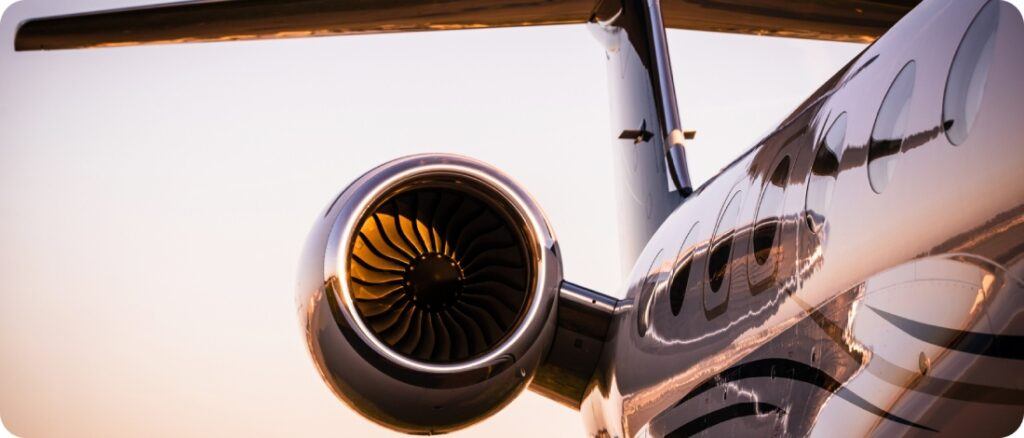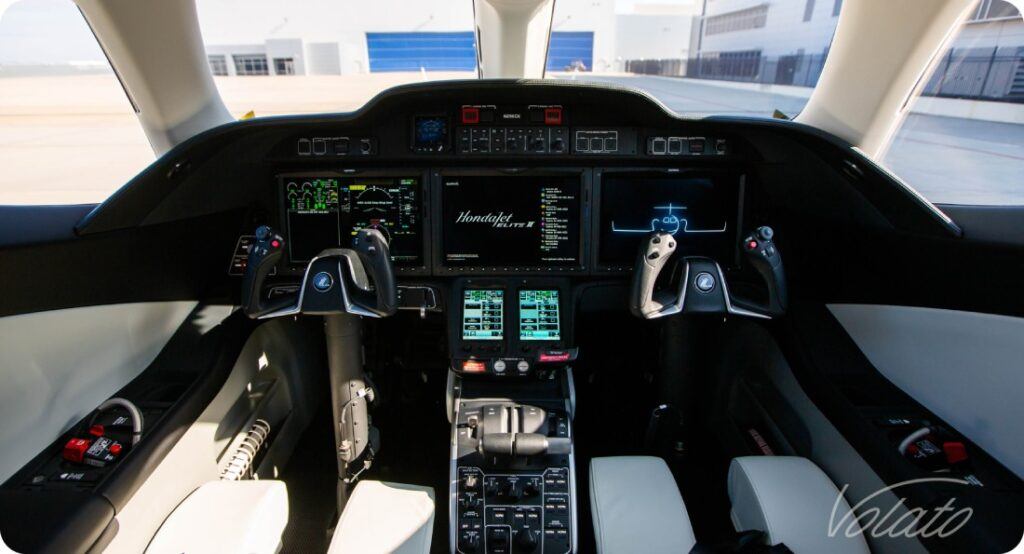Honda Jet specs are nothing short of revolutionary. They have pushed this relative newcomer in the executive jet manufacturing space to rapidly become a global leader. Farther, faster, and higher — by almost every conceivable measure, HondaJet’s performance outranks all other aircraft in their market.
What technical aspects make these jets the preferred way to travel among elite flyers? With two Honda Jet models already in the sky (the HA-420 and the Elite II) and a third just announced (2600 Concept), let’s look at the Honda Jet features that set this brand apart.
Specifications of HondaJet HA-420.
The HondaJet HA-420 is the model that launched it all. The original HondaJet pioneered several technological developments that have pushed the entire Very Light Jet (VLJ) category to new heights, literally.
First is the Over-The-Wing Engine Mount design, which allows for a much more spacious interior while reducing cabin noise. It also ensures much greater fuel efficiency over other models in its class. This design enables the HondaJet to fly faster, higher, and further than all other models in its class.
Second is the advanced cockpit design engineered in partnership between Honda and Garmin. As Honda states, “The cockpit is unquestionably built around the pilot,” enabling greater safety and situational awareness.
Speed
Max cruise speed: 422 knots true airspeed (KTAS) (782 km/h)
Range
Max range: 1223 nm (2265 km)
Engine
GE Honda / HF120
Equipment
- Customized Garmin G3000 avionics system
- 3x 14-inch high-resolution displays
- 2x touchscreen controllers
Fuel efficiency
Average fuel usage: 102 gallons per hour* (or 4 miles per gallon)
*Fuel efficiency breakdown by specific mission profiles available here.
Cabin space
Length: 17.80 ft (5.43 m)
Width: 5.00 ft (1.52 m)
Height: 4.83 ft (1.47 m)
Typical cabin configuration: 2 crew + 4 passengers
Alternative configuration: 2 crew + 5 passengers
Baggage space
Max capacity: 66 cubic ft
Exterior
Wingspan: 39.76 ft (12.12 m)
Height: 14.90 ft (4.54 m)
Length: 42.62 ft (12.99 m)
Specifications of HondaJet Elite II.
The HondaJet Elite II builds on what the HondaJet HA-420 started. Built on the same foundational systems, including the Over-The-Wing Engine Mount and Natural Laminar Flow, it achieves greater fuel efficiency, range, and performance to take passengers farther than ever.
Yet, beyond range and altitude upgrades, one of the most notifiable updates of the Elite II has to do with the interior. You can now expect a fully enclosed lavatory with ceiling skylights, swivel-seating laid out in an executive club arrangement, and improved cabin acoustics.
The Elite II Honda Jet specs are setting new industry standards for what’s possible for VLJ aircraft.

Speed
Max cruise speed: 422 KTAS (782 km/h)
Range
Max range: 1547 nm (2865 km)
Engine
GE Honda / HF120
Equipment
- Customized Garmin G3000 avionics system
- Automated anti-ice, lighting, and pressurization systems
- Automated ground spoilers for takeoff and landing performance
- Advanced steering and augmentation system
- Stabilized approach system
- Garmin® Autoland emergency control system
- Autothrottle power management system
- Bongiovi aviation sound system
Fuel efficiency
Average fuel efficiency: 90 gallons per hour (or 3.85 miles per gallon)
Cabin space
Length: 17.80 ft (5.43 m)
Width: 5.00 ft (1.52 m)
Height: 4.83 ft (1.47 m)
Typical cabin configuration: 2 crew + 4 passengers
Alternative configuration: 2 crew + 5 passengers
Baggage space
Combined max capacity: 62 cubic ft.
Exterior
Wing Span: 39.76 ft (12.12 m)
Height: 14.90 ft (4.54 m)
Length: 42.62 ft (12.99 m)
HondaJet 2600 Concept.

In June 2023, Honda announced plans for a new aircraft: The HondaJet 2600 Concept. This will be the third model in their fleet, and as a Light Jet, it is a brand-new class type for the manufacturer.
The HondaJet 2600 Concept is scheduled to start rolling out of production in 2028. By jumping up in class and larger HondaJet dimensions, these new executive jets can accommodate upwards of nine passengers. The new Honda Jet specs promise the best-in-class fuel efficiency and a range large enough to travel non-stop from coast-to-coast — and beyond.
Speed
Maximum speed: 450 KTAS (834 km/h)
Range
Maximum range: 2625 nm (4862 km)
Engine
Honda Jet engine is yet to be announced
Equipment
- Customized Garmin G3000 avionics system
- Autothrottle power management system
- Garmin® Autoland emergency control system
- Advanced Steering Augmentation System (ASAS)
- Runway overrun awareness and alerting system (ROAAS)
- Autobrake during takeoff and landing
Fuel efficiency
Average fuel efficiency: predicted to be 20 percent more efficient than other jets in its class.
Cabin space
Length: 25.38 ft (7.74 m)
Width: 5.08 ft (1.55 m)
Height: 5.21 ft (1.59 m)
Typical cabin configuration: 1 crew + 10 passengers
Alternative configuration: 2 crew + 9 passengers
Baggage space
Combined max capacity: 120 cubic ft.
Exterior
Wing Span: 56.72 ft (17.29 m)
Height: 15.86 ft (4.84 m)
Length: 57.79 ft (17.62 m)
Compare HondaJet specifications.
| HondaJet HA-420 | HondaJet Elite II | HondaJet 2600 Concept | |
|---|---|---|---|
| Jet Class | Very Light Jet | Very Light Jet | Light Jet |
| Max Speed | 422 KTAS | 422 KTAS | 450 KTAS |
| Max Range | 1223 nm | 1547 nm | 2625 nm |
| Passenger Capacity | 4 + 2 Crew | 4 + 2 Crew | 9 + 2 crew |
| Baggage Capacity | 66 cubic ft. | 62 cubic ft. | 120 cubic ft. |
| Fuel Efficiency | 102 gallons per hour | 90 gallons per hour | Celda 28 |
HondaJet FAQs.
How fast does the Honda Jet fly?
The max speed of both the original HondaJet and the Elite II is 422 KTAS or 782 km/h. Achieving this speed depends on winds, and total passenger, fuel, and baggage weight, among other factors. HondaJet’s speed has designated it as the fastest in its class.
What is the seating capacity of the Honda Jet?
The HondaJet was designed from the start to fit the owner’s needs, which means each model has several possible cabin configurations.
A typical configuration for the HA-420 and the Elite II is two crew plus four passengers, or alternatively, one crew plus five passengers. Honda also offers an alternative configuration that can accommodate upwards of two crew and five passengers.
As a slightly larger aircraft (Light Jet), the 2600 Concept is expected to have a much greater seating capacity, with the typical arrangement accommodating up to two crew and nine passengers.
How far can the Honda Jet travel on a single tank of fuel?
According to HondaJet specifications for the original HA-420, the maximum range is 1223 nm under optimal conditions, while the Elite II can travel 1547 nm. When the new 2600 Concept launches in 2800, this very light jet will be able to hit distances of up to 2625 nm.
Is the Honda Jet’s climb rate impressive?
The Honda Jet engine pushes the craft to climb 3990 feet per minute to reach a cruising altitude of 43,000 feet (the highest in its class). This helps it achieve greater fuel economy than all other VLJ models. As a comparison, most business jets hit a cruising altitude max of 38,000 feet.
How does the Honda Jet’s speed compare to other jets in its class?
Thanks to the unique foundation design features, including Natural Laminar Flow, Composite Fuselage, and Over-The-Wing-Engine Mount, HondaJets can fly faster than other models in their classes.
| Model | Speed |
|---|---|
| HondaJet HA-420 & Elite II | 422 ktas |
| Cessna Citation M2 | 404 ktas |
| Embraer Phenom 100EV | 406 ktas |
What are the unique Honda Jet specs that set the brand apart?
Several key Honda Jet features set it apart from other VLJ models. The first is the Over-The-Wing-Engine Mount. By moving the engine and engine structures from the tail to the wing, Honda’s engineers ensured more cabin space and better fuel efficiency while simultaneously reducing cabin noise.
Another key design element is the Natural Laminar Flow of the aircraft’s wings (airfoil) and nose. According to Honda, this reduces drag while in flight compared with a turbulent flow design. The ancillary benefits are better fuel efficiency and cruising speed.
Finally, Honda has built all models of its jets with a carbon composite fuselage. That means it’s stronger and lighter than comparable jets made from aluminum. The carbon composite combines a honeycomb and stiffened panels to create the final fully optimized fuselage shape.
How does the Honda Jet perform in terms of fuel efficiency?
Many factors, including headwinds, weather, and aircraft load, influence fuel efficiency. Altering any of these will change how far the jet will travel per gallon of fuel.
The Honda Jet performance specs are setting new efficiency standards for the industry. Under ideal conditions, the HA-420 and the Elite II get 104 and 90 gallons per hour, respectively. Then, when the 2600 launches, it’s already projected to have 20 percent better fuel efficiency than all other jets in its class.
By comparison, the Cessna Citation M2 only achieves 120 gallons per hour, while the Embraer Phenom 100 could burn as much as 130.
Can the Honda Jet handle short runways?
Yes, all Honda Jet models are ideally suited to short runways and therefore have access to thousands of smaller airports that would otherwise be inaccessible.
The HondaJet HA-420 requires just over 4000 ft (1219 m) to take off and 3,050 ft (930 mt) to land. The Elite II requires a runway of 3,699 ft (1,128 m) to take off and a landing of 2717 ft (829 m).
What is the range of the Honda Jet on a typical flight?
The Honda Jet specifications detail that the HA-420 has a max range of 1223 nm, and the Elite II has a slightly greater range of 1547 nm.
With more than four occupants, significant headwinds, or excess baggage, the total range will be less.

Faster, farther, and with better fuel efficiency:
HondaJet dominates the skies.
Whether you’re impressed by technical specs, best-in-class cabin comforts, or HondaJet’s incredible fuel efficiency, there is more than one reason to fly with Honda. In the VLJ and soon-to-be-launched Light Jet categories, Honda aircraft specifications continue to perform better than their competitors.
HondaJet’s speed, range, and interior comforts are part of why they’ve become a staple in the Volato fleet. Honda Jet’s performance specs ensure we continue delivering the best-in-class experience to our customers without compromising flight safety.
Ready to fly with Volato? Book a flight today.